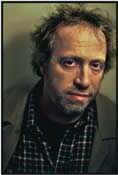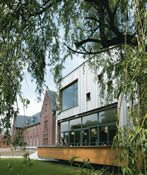Inflight Magazine of Brussels Airlines
Welcome to the Inflight Magazine of Brussels Airlines
In person
Text Sheridan Becker
Images Kris Dewitte, Rex Features, L. Denruyter, Cinematek.be
 Jaco Van Dormael
Jaco Van Dormael
Billed as the wunderkind of world cinema, Jaco Van Dormael has impressed both critics and audiences worldwide with award-winning films such as Le Huitième Jour and Toto le Héros. His latest, Mr. Nobody, had a €37m production budget, making it the most expensive Belgian film ever made. From his home in Uccle, Van Dormael talks to b.there! about making Mr. Nobody, and what inspires him
I was born in Belgium.
My mother is French-speaking and my father is Flemish-speaking, but I grew up in Germany until I was seven years old. The mixing of cultures, styles and languages feels normal for me, especially here in Brussels. This is probably one of the reasons Brussels has many talented painters, dancers, musicians and photographers – all kinds of artists.
When casting for Mr. Nobody, I chose the child actors before I found my main actors.
Surprisingly, I discovered my child actors right away. That’s because our child actors were from England; in England there is a strong foundation and tradition in theatre and the arts. Then Jared Leto was on tour in Europe, and he read the Mr. Nobody script and said he was very interested in playing the leading role. My first meeting with Jared was at one of his concerts, held in Amsterdam. I was quite surprised by this initial meeting because I knew him as an actor – I didn’t know he was a full-time musician. I was shocked to see these thousands of women collapsing, crying, falling and screaming all over him!
 Half of Mr. Nobody was shot in Belgium.
Half of Mr. Nobody was shot in Belgium.
In Brussels we had five working sets available to use simultaneously. We also filmed in a neighbourhood called Watermael-Boitsfort – it’s an area where I shoot all my films because, for me, this part of town represents a childhood village. The neighbourhood encompasses about 50 streets where every house looks similar. Everything is green, with pink trees. All the gardens connect with their neighbour’s garden, so children end up running around from one garden to another. The area is like a social utopia from the last century. Another asset here is that every street looks like every other street, so when there was a problem with the sun we just changed the street!
I met Christophe Beaucarne, my cinematographer, when he was 18 years old.
He was one of my students at film school. We have known each other for over 30 years. We have a great chemistry working together, and we have a lot of fun pushing and upgrading each other’s ideas.
 When I was a child I was fascinated by a film called Intolerance: Love’s Struggle Throughout the Ages.
When I was a child I was fascinated by a film called Intolerance: Love’s Struggle Throughout the Ages.
An American film that was directed by DW Griffith, it’s considered to be a masterpiece of the silent era. There are films that try to simplify the world and provide answers, and then there are films like Intolerance that try to say the world is very complex and that we don’t have answers. I’m interested in making films that make people ask questions, rather than providing answers. I think we have to leave the simple answers to advertising and, say, politics. It’s important to remember that our world is complex. Perhaps we don’t have all the answers.
Jaco’s Belgium
The director shares his favourite cinemas, restaurants and watering holes
Favourite area Watermael-Boitsfort – the Brussels neighbourhood that features in several of my films. The ‘happiness for all’ image is what clearly comes to mind here, and neighbours seem to appreciate and share each other’s space.
Favourite restaurants In Uccle, Le Comptoir d’Antoine (48 Rue Victor Allard, tel. ) does great food, while I also like Italian restaurant Caffè al Dente (87 Rue du Doyenné, tel. ), which offers simple and friendly service. I admire the enormous collection of Italian wines this place has! Situated near Lake Genval in the south-east of Brussels, La Métisse (2 Zilverbeekdreef, tel. ) is without a doubt the best place in town for inventive African food in a friendly atmosphere.
n Favourite bars Brussels’ Café Belga (18 Place Eugène Flagey) is always lively. I’ve also been a frequent visitor for years and years of the classic L’Archiduc (6 Rue Antoine Dansaert).
Favourite cinemas I like to go to Cinematek (9 Rue Baron Horta) in Brussels because you can see films here that aren’t screened anywhere else in town.
I also like what’s probably considered the last ‘family owned’ film theatre in Belgium, Ciné Centre (91 Avenue de Mérode) in Rixensart. These folks are still going, and that’s because they love what they do – show great-quality films. And Brussels’ classic ‘Eldorado’ (38 Place de Brouckère) is marvellous, with a huge African art-inspired art deco screening room.
Favourite museum Musée de la Photographie in Charleroi (11 Avenue Paul Pastur, museephoto.be). It contains an enormous collection of both modern and old photographs. I appreciate the skill and craft of Léonard Misonne, a photographer from the beginning of the 20th century who used a unique procedure to paint on photographs.
Favourite place to visit when in Brussels Bois de la Cambre: it’s quite literally a forest located in the middle of a metropolitan city.
Leave a Reply
